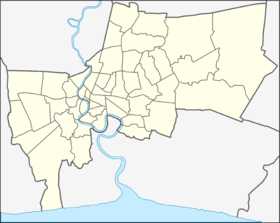- Wat Benchamabophit
-
Wat Benchamabophit 
The Ordination Hall (Ubosot) Information Denomination Theravada Buddhism Founded 1911 A.D.[1] Founder(s) Prince Naris[1] Country Thailand Coordinates Coordinates: 13°45′58″N 100°30′51″E / 13.76611°N 100.51417°E Wat Benchamabophit Dusitvanaram (Thai: วัดเบญจมบพิตรดุสิตวนารามราชวรวิหาร) is a Buddhist temple (wat) in the Dusit district of Bangkok, Thailand. Also known as the marble temple, it is one of Bangkok's most beautiful temples and a major tourist attraction. It typies Bangkok's ornate style of high gables, stepped-out roofs and elobrate finials.[2]
Contents
Construction
Construction of the temple began in 1899 at the request of King Chulalongkorn after building his palace nearby. The temple's name literally means the Temple of the fifth King located nearby Dusit Palace. It was designed by Prince Naris, a half-brother of the king, and is built of Italian marble.[1] It has display of carrarra marble pillars, a marble courtyard and two large singhas guarding the entrace to the bot. The interiors are decorated with crossbeams of lacquer and gold, and in shallow niches in the walls of paintings of important stupas all over the country.[1] The cloister around the assembly hall houses 52 images of Buddha.[1]
The Temple
Inside the ordination hall (ubosot) is a Sukhothai-style Buddha statue named Phra Buddhajinaraja, cast in 1920 after the original located in Wat Mahathat in Phitsanulok. The main Buddha iamge is a copy of Phra Buddha Chinarat that resides in Phitsanulok in northern Thailand.[3] The ashes of King Chulalongkorn are buried beneath the statue. In the gallery surrounding the ordination hall are 52 buddha statues each showing different mudras (signs),[3] collected by Prince Damrong Rajanubhab for his king. The temple was featured in the famous The Amazing Race 9 as the 10th and final elimination pit-stop. The image of the temple's façade is visible on the reverse side of the Five-Baht coin of the Thai currency. The site contains the Benchamabophit National Museum.
Worship and Festivals
Merit makers come to the monks of the temple for getting alms every morning. Between 6-7:30 in the morning, the monks line up on Nakhon Phantom with their bowls to receive donations of curry, rice, lotus buds, incense, toilet papers and coco-cola.[4] The evening candlelight procession around the bot during the Buddhist festivals of Maha Puja (in February) and Visakha Puja (in May) are common for this temple.[4]
Protection
In 2005, the temple was submitted to UNESCO for consideration as a future World Heritage Site.
Image Galleries
-
A new monk is being ordained in the temple
-
Monks as seen from the outside (photography is not permitted inside the temple)
External links
Notes
References
- Spooner, Andrew; Hana Borrowman, William Baldwin (2011), Footprint Thailand, UK: www.footprintbooks.com, ISBN 978-1-904777-946, http://books.google.com/books?id=z9RsdHajfucC&pg=PA99&dq=wat+arun&hl=en&ei=b320Tu2WJsectwfTiOTwAw&sa=X&oi=book_result&ct=result&resnum=4&ved=0CEEQ6AEwAw#v=onepage&q=isbn&f=false
- Ridout, Lucy; Paul Gray (2009), The Rough Guide to Thailand's Beaches & Islands, India: Rough Guides, ISBN 978-7-84836-091-4, http://books.google.com/books?id=SiusMRRcvS4C&pg=PT270&dq=wat+arun&hl=en&ei=jn-0Tp-xMMG1twebwOHkAw&sa=X&oi=book_result&ct=result&resnum=5&ved=0CEgQ6AEwBA#v=onepage&q=wat%20arun&f=false
- Norwich, John Julius (2001), Great architecture of the world, USA: De Capo Press Inc., ISBN 0-306-81042-5, http://books.google.com/books?id=Oo2BjGYRIT0C&pg=PA266&dq=wat+arun&hl=en#v=onepage&q=isbn&f=false
- Emmons, Ron (2008), Top 10 Bangkok, New York: DK, ISBN 978-0-7566-186-1, http://books.google.com/books?id=ebnIm-cEt5sC&pg=PA26&dq=wat+arun&hl=en#v=onepage&q=wat%20arun&f=false
Categories:- Buddhist temples in Bangkok
- Museums in Bangkok
Wikimedia Foundation. 2010.









